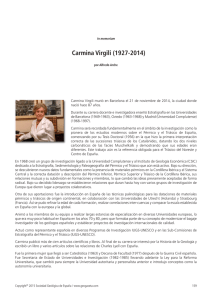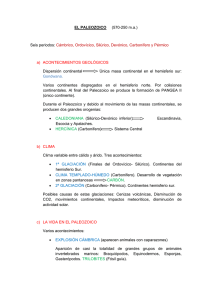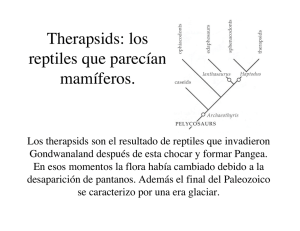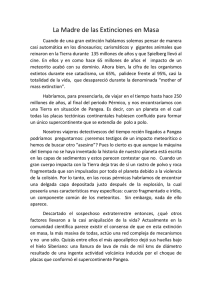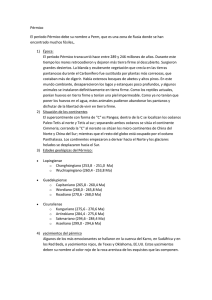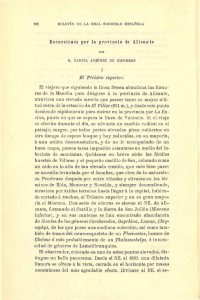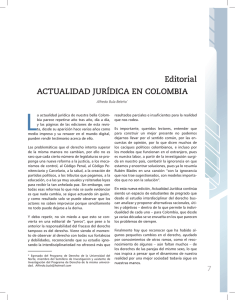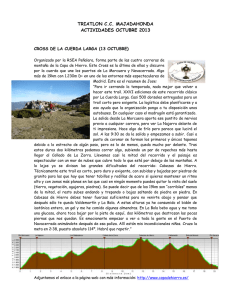Important geosites and parks in the UNESCO World Heritage Site of
Anuncio
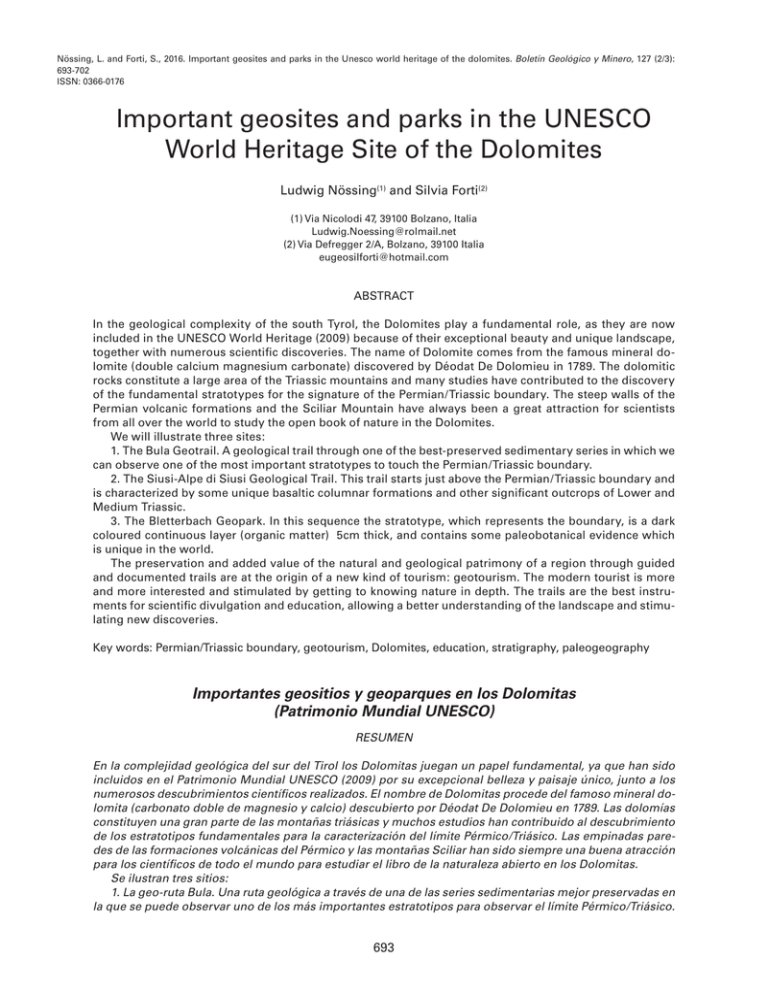
Nössing, L. and Forti, S., 2016. Important geosites and parks in the Unesco world heritage of the dolomites. Boletín Geológico y Minero, 127 (2/3): 693-702 ISSN: 0366-0176 Important geosites and parks in the UNESCO World Heritage Site of the Dolomites Ludwig Nössing(1) and Silvia Forti(2) (1) Via Nicolodi 47, 39100 Bolzano, Italia [email protected] (2) Via Defregger 2/A, Bolzano, 39100 Italia [email protected] ABSTRACT In the geological complexity of the south Tyrol, the Dolomites play a fundamental role, as they are now included in the UNESCO World Heritage (2009) because of their exceptional beauty and unique landscape, together with numerous scientific discoveries. The name of Dolomite comes from the famous mineral dolomite (double calcium magnesium carbonate) discovered by Déodat De Dolomieu in 1789. The dolomitic rocks constitute a large area of the Triassic mountains and many studies have contributed to the discovery of the fundamental stratotypes for the signature of the Permian/Triassic boundary. The steep walls of the Permian volcanic formations and the Sciliar Mountain have always been a great attraction for scientists from all over the world to study the open book of nature in the Dolomites. We will illustrate three sites: 1. The Bula Geotrail. A geological trail through one of the best-preserved sedimentary series in which we can observe one of the most important stratotypes to touch the Permian/Triassic boundary. 2. The Siusi-Alpe di Siusi Geological Trail. This trail starts just above the Permian/Triassic boundary and is characterized by some unique basaltic columnar formations and other significant outcrops of Lower and Medium Triassic. 3. The Bletterbach Geopark. In this sequence the stratotype, which represents the boundary, is a dark coloured continuous layer (organic matter) 5cm thick, and contains some paleobotanical evidence which is unique in the world. The preservation and added value of the natural and geological patrimony of a region through guided and documented trails are at the origin of a new kind of tourism: geotourism. The modern tourist is more and more interested and stimulated by getting to knowing nature in depth. The trails are the best instruments for scientific divulgation and education, allowing a better understanding of the landscape and stimulating new discoveries. Key words: Permian/Triassic boundary, geotourism, Dolomites, education, stratigraphy, paleogeography Importantes geositios y geoparques en los Dolomitas (Patrimonio Mundial UNESCO) RESUMEN En la complejidad geológica del sur del Tirol los Dolomitas juegan un papel fundamental, ya que han sido incluidos en el Patrimonio Mundial UNESCO (2009) por su excepcional belleza y paisaje único, junto a los numerosos descubrimientos científicos realizados. El nombre de Dolomitas procede del famoso mineral dolomita (carbonato doble de magnesio y calcio) descubierto por Déodat De Dolomieu en 1789. Las dolomías constituyen una gran parte de las montañas triásicas y muchos estudios han contribuido al descubrimiento de los estratotipos fundamentales para la caracterización del límite Pérmico/Triásico. Las empinadas paredes de las formaciones volcánicas del Pérmico y las montañas Sciliar han sido siempre una buena atracción para los científicos de todo el mundo para estudiar el libro de la naturaleza abierto en los Dolomitas. Se ilustran tres sitios: 1. La geo-ruta Bula. Una ruta geológica a través de una de las series sedimentarias mejor preservadas en la que se puede observar uno de los más importantes estratotipos para observar el límite Pérmico/Triásico. 693 Nössing, L. and Forti, S., 2016. Important geosites and parks in the Unesco world... Boletín Geológico y Minero, 127 (2/3): 693-702 2. La ruta geológica Siusi-Alpe di Siusi. Esta ruta comienza justo sobre el límite Pérmico/Triásico y está caracterizado por algunas formaciones basálticas columnares únicas, así como otros afloramientos del Triásico Inferior y Medio. 3. El geoparque Bletterbach. En esta secuencia el estratotipo que representa el límite Pérmico/Triásico es una capa continua de coloración oscura (materia orgánica) de 5 cm de espesor y que contiene algunas evidencias paleobotánicas que son únicas en el mundo. La preservación y el valor añadido del patrimonio geológico y natural de una región a través de rutas guiadas y documentadas son el origen de una nueva clase de turismo: el geoturismo. El turista moderno está cada vez más interesado y estimulado por conocer la naturaleza en profundidad. Las rutas son el mejor instrumento para la divulgación científica y la educación, permitiendo una mejor lectura del paisaje y estimulando nuevos descubrimientos. Palabras clave: límite Pérmico/Triásico, geoturismo, Dolomitas, educación estratigrafía, paleogeografía VERSIÓN ABREBIADA EN CASTELLANO Introducción Los Dolomitas están situados en el norte de Italia, en las regiones de Trentino-Alto Adige (Sur del Tirol), Veneto y Friuli (Fig. 1). Esta parte de los Alpes tiene una extensión de unos 8750 km. Desde 2009 los Dolomitas forman parte de la UNESCO World Heritage. El nombre viene de Déodat De Dolomieu, que descubrió el famoso mineral de carbonato doble de calcio y magnesio: la dolomita. Desde un punto de vista esctructural, los Dolomitas son un sinclinorio extendido en el sur de los Alpes. Las rocas, que se formaron desde el Pérmico hasta el Triásico, son volcánicas y sedimentarias. En las secuencias estratigráficas se pueden encontrar arrecifes de coral, depósitos de cuenca someros y de mar abierto, y sedimentos de plataforma. El límite Pérmico/Triásico constituye uno de los más importantes puntos de la geología de los Dolomitas, famoso por su mundo fantástico de arrecifes de coral. Son un ejemplo único del ambiente de arrecifes de coral que se desarrollaron en un mar tropical. Las capas litológicas están bien documentadas, pudiendo ser accesibles a personas que no son expertos. Este trabajo analiza algunos enfoques prácticos de acercamiento a las Ciencias de la Tierra. Estudiantes de geología así como naturalistas y público en general interesado en las Ciencias Naturales puede descubrir la singularidad de esta naturaleza. El límite Pérmico/Triásico está bien representado en el borde noroeste del sinclinorio. Los perfiles analizados están localizados básicamente en la provincia de Bolzano ((Alto Adige/South Tyrol). Los geositios son los siguientes: georuta Bula en el área de Ortisei/Alpe di Siusi), la ruta Siusi-Alpe di Siusi y el geoparque Bletterbach. Visión de conjunto estratigráfica y paleogeográfica La secuencia sedimentaria en los Dolomitas se extiende desde el Pérmico superior hasta el Cretácico. En los perfiles examinados nos concentraremos en el período que va del Pérmico superior al Triásico inferior, tal y como se muestra en la secuencia estratigráfica de Bula. Este período está bien documentado y detallado en Bula y contiene a los miembros Bula Mazzin. Este perfil es el que tiene el mayor interés, pues presenta una buena exposición del límite Pérmico/Triásico a lo largo del trayecto. Ha sido posible documentar este límite centímetro a centímetro. Muchas secciones delgadas y todos los datos bioestratigráficos, geoquímicos y paleomagnéticos han permitido una buena documentación del perfil. Brandner et al. (2012) demostraron que se trata de una secuencia continua. Gracias a estos estudios ha sido posible localizar el límite en los eventos estratigráficos. Las secciones delgadas pueden evidenciar las condiciones marinas continuas, sin ninguna interrupción sedimentaria. Las condiciones climáticas estuvieron siempre caracterizadas por las altas temperaturas y la falta de exposición al aire. Desde el punto de vista bioestratigráfico se puede detectar una pequeña interrupción que subraya el evento, y después resurgen colonizaciones de moluscos de pequeño tamaño con conchas delgadas y frágiles. La secuencia litoestratigráfica completa está bien ilustrada en la figura 2, comenzando desde el Pérmico con el grupo volcánico ´Artesino´ (llamado ´pórfido cuarcífero´ de Bolzano) hasta los depósitos del Neocomiano. La paleogeografía del Pérmico superior está marcada por la descomposición de Pangea debido a la orogénesis Varisca. La transgresión del mar de Tetis comienza desde el este sobre las superficies áridas de paleo-Europa. Algunas vistas esquemáticas de estas condiciones están bien ilustradas en las figuras 3 y 4 (de Bosellini, 1989). Toda la región estaba caracterizada por un mar de agua somera en varias cuencas separadas, algunas plataformas continentales y paisajes pantanosos. La naturaleza de los materiales depositados es carbonatada o arcillosa, en función 694 Nössing, L. and Forti, S., 2016. Important geosites and parks in the Unesco world... Boletín Geológico y Minero, 127 (2/3): 693-702 de la profundidad del agua. Las oscilaciones del nivel del mar eran muy frecuentes y se pueden observar muy bien en muchas secuencias de las capas de rocas del Pérmico superior y Triásico. En la formación Bellerophon, del Pérmico Superior, es posible observar algunas capas de yeso, que disminuyen en los niveles Werfen. Rutas geológicas Se presenta la compleja temática geológica a través de los siguientes geositio: georuta Bula, la ruta geológica Siusi - Alpe di Siusi y el geoparque Bletterbach. La georuta Bula/Bulla (Fig. 5) es una ruta circular, para realizar a pie, en el norte de las pendientes de la montaña Bullaccia. Se pueden encontrar ocho paradas a lo largo de la ruta donde los paneles explican en cuatro lenguajes las características geológicas del recorrido. El panel fundamental es el número 2 (Fig. 6) donde el caminante puede físicamente ir a través del límite entre el Pérmico y el Triásico, que marca uno de los más importantes cambios concernientes a la evolución de la vida en nuestro planeta. Hace unos 250 millones de años una extinción en masa terminó con el 90 % de los seres vivos debido a gigantescas erupciones volcánicas. Dos gráficos muestran los datos geoquímicos y geofísicos. Es posible observar la rápida disminución en el contenido en carbono 13 correspondiente al evento límite. Esto sugiere una disminución de la vida orgánica en el medio marino, en concordancia con lo que se puede observar en las secciones delgadas. En el mismo período se puede observar una inversión del campo magnético terrestre. En las paradas 3 a 5 se explican la estratigrafía y las condiciones ambientales. En las paradas 6 y 7 se explica la tectónica y en la 8 los procesos geodinámicos que durante el Cuaternario, 2200 años antes del presente, fueron responsables del deslizamiento Pontives. Geo-ruta Siusi-Alpe di Siusi (Fig. 12) Esta ruta presenta bellos e impresionantes paisajes desde un punto de vista panorámico y geológico. La mayor parte de la ruta se desarrolla a lo largo de un cañón muy encajado y modelado por el torrente ´Froetschbach´. Esto permite una vista excelente de los afloramientos. Desde un punto de vista estratigráfico, el recorrido comienza justo por encima del límite Pérmico/Triásico, en correspondencia con el Anisiano superior y se extiende al límite Ladiniano-Carniano. Las capas Wengen son impresionantes con rocas ígneas basálticas que presentan estructuras columnar (Fig. 8) y de lavas almohadilladas. También se observan los bloques de la caliza Cipit que contiene una rica fauna de arrecifes de coral y ”lagoons”. Geoparque Bletterbach (Fig. 9) Este geoparque está situado en Aldino, parte sur del Tirol, en el Parque Natural de Trudner Horn. Diferentes recorridos de variada dificultad permiten descubrir la historia geológica de la unidad sur alpina desde el Pérmico al Triásico inferior, a través de evindencias paleontológicas y palinológicas. En detalle se pueden observar la siguientes formaciones: Areniscas Val Gardena. Durante el mismo período, hace 270 millones de años, el área de los Dolomitas era muy similar a la actual región del Golfo Pérsico, caracterizada por tanto por una extensa llanura surcada por ríos dirigiéndose hacia el mar (Fig. 2). La parte baja de las capas está dominada por el color rojo debido a la oxidación (hierro férrico) en condiciones de aire libre. El ambiente también estaba dominado por abanicos aluviales y algunos valles que fueron progresivamente rellenos de sedimentos fluviales. La presencia de grietas de retracción confirma el clima seco y cálido. La parte alta está caracterizada por colores grises y grises oscuros. Esto es una indicación clara de un cambio climático con incremento de la lluvia y la escorrentía continental: los valles se rellenaron de sedimentos fluviales y los ríos fluyeron a través de una llanura húmeda, cada vez más cerca del mar. La vegetación era asimismo cada vez más abundante. A lo largo del Cañon Bletterbach es posible observar una capa continua de calizas grises debido a la primera incursión marina (presencia de nautiloideos). Bellerophon. Las capas Bellerophon son fácilmente distinguibles por su color gris y la presencia de nódulos de yeso. Desde el punto de vista estratigráfico es la última formación del Pérmico superior. Las llanuras aluviales fueron transformadas en un golfo tropical con aguas cálidas someras. La precipitación era muy rara y estas condiciones favorecieron la formación de capas de evaporitas. El nombre procede de la presencia de un gasterópodo de gran tamaño Bellerophon, capaz de sobrevivir en condiciones extremas (hipersalinas). 695 Nössing, L. and Forti, S., 2016. Important geosites and parks in the Unesco world... Boletín Geológico y Minero, 127 (2/3): 693-702 Werfen Formation. La formación del Trias inferior está representada por las capas Werfen que están constituidas por lutitas y limolitas bien estratificadas de color rojo a verde y depositadas en condiciones de agua somera con eventos de tormenta bien documentados. Es un mar abierto aunque el agua nunca alcanza profundidades superiores a los 50 m. Los fósiles son abundantes pero son pequeños y poco diferenciados. Esto es una evidencia de la extinción en masa en el límite Pérmico/Triásico. Conclusiones Hemos recorrido el límite Pérmico/Triásico en tres sitios fundamentales situados en los Dolomitas del sur del Tirol (Alto Adige). Estas rutas son bien conocidas a través de numerosas publicaciones científicas. La primera, Bula, es ciertamente la más significativa ya que contiene la sección clave que constituye un estratotipo mundial fundamental. El límite Pérmico/Triásico está bien documentado desde un punto de vista geoquímico, paleomagnético y estratigráfico. También se observan algunas formaciones estromatolíticas en el nivel correspondiente al comienzo de las capas triásicas. La segunda ruta, Siusi, es significativa por la geología triásica y la peculiaridad de sus afloramientos (basaltos columnares, arrecifes de coral, cenizas volcánicas de colores verdosos). Estos sitios pueden ser visitados con algunos guías expertos de la Oficina Geológica de la Provincia de Bolzano (Dr. L. Nössing). La tercera ruta, Bletterbach, documenta el límite Pérmico/Triásico desde un punto de vista paleontológico y palinológico (E. Kustatscher). Este geositio es conocido mundialmente y está muy bien documentado por un gran número de publicaciones (E. Kustatscher) y está equipado con un museo y guías especializados para estudiantes y excursionistas. Introduction The Dolomites are situated in the north of Italy, in the regions of Trentino-Alto Adige (South Tyrol), Veneto and Friuli (Fig. 1). This part of the Alps has an extension of around 8 750 km. Since 2009 the Dolomites have been part of UNESCO World Heritage. The name comes from Déodat de Dolomieu, who discovered the famous mineral made of calcium magnesium double carbonate: the dolomite. From a structural point of view, the Dolomites are an extended synclinorium in the southern Alps. The rocks that were formed from the Permian to the Triassic are volcanic and sedimentary. Coral reefs, shallow and open water basin deposits, and platform sediments can be found as lateral or over lain irregular sequences. The Permian/Triassic boundary constitutes one of the most important points of Dolomite geology, famous for its fantastic world of coral reefs. It is a unique example of a coral-reef environment, which developed in a tropical sea. The rock layers are well documented and are accessible to people who are not experts. This article analyzes some different practical approaches to Earth Sciences. Not only Geology students, but also scholars and people who are interested in Natural Sciences, can discover the peculiarity of this environment. Figure 1. Regional geologic overview with location of some excursion areas in the Dolomites (from R. Brandner and L. Kiem, 2011). Figura 1. Panorámica de la geología regional con la localización de algunas áreas de excursión en los Dolomitas (de R. Brandner and L. Kiem, 2011). 696 Nössing, L. and Forti, S., 2016. Important geosites and parks in the Unesco world... Boletín Geológico y Minero, 127 (2/3): 693-702 The Permian/Triassic boundary is very well represented at the northwest border of the synclinorium. The analyzed profiles are mostly located in the Province of Bolzano (Alto Adige/South Tyrol). The geosites are the following: The Bula Geotrail in the area of Ortisei/Alpe di Siusi); The Siusi-Alpe di Siusi trail; The Bletterbach Geopark. These three geotrails are important for their peculiar landscape and for their scientific importance as reported in the critical revision of E. Farabegoli and D. Tonidandel (2012). Stratigraphic and Paleogeographic overview The sedimentary sequence in the Dolomites extends from the upper Permian to the Cretaceous. In the examined profiles we will focus on the period from the upper Permian to the Lower Triassic, as shown in the stratigraphic Bula sequence. This period is well documented and in detail at Bula and contains the Bula and Mazzin members. This profile deserves the highest attention, as the Permian/ Triassic boundary is well exposed and visible along the trail. It has been possible to document this limit centimetre by centimetre from many thin sections, as all bio-stratigraphic, geochemical and paleo-magnetic data have allowed a good documentation of this profile. R. Brandner et al. in 2012 demonstrated that it is a continuous sequence. Thanks to these studies it has been possible to localize the limit in the stratigraphic events. The thin sections evidence the continuous marine conditions, then without any sedimentary interruptions. The climatic conditions have always been characterized by high temperatures without any air exposition. From a bio-stratigraphic point of view it is possible to notice a small interruption, which underlines the event, after the revival of small sized mollusk colonization with thin and fragile shells. The whole lithostratigraphic sequence is well illustrated in Figure 2, beginning from the Permian with the volcanic “Atesino” group (named “Porfido quarzifero”of Bolzano) until the Neocomian deposits. The Upper Permian paleogeography is marked by the Pangea decomposition due to the Varisian Orogenesis. The transgression of the Thétys basin starts from the east on the arid surfaces of the paleo Europe. Some schematic views of these conditions are well illustrated in Figure 3 (from A. Bosellini, 1989), and in Figure 4 (from A. Bosellini, 1996). The whole region was characterized by a shallow water sea and separated basins, some continental platforms and marshy landscapes. The nature of the materials which are deposited, carbonate or clayey, depends on the water depth. The sea level oscillations were very frequent, and can be well observed in many sequences of the Upper Permian and Triassic rock layers. In the Upper Permian Bellerophon formation, it is possible to observe some gypsum layers, which decrease in the Werfen levels. Geological trails We will present the complex geologic thematic through the following geo sites: The Bula Geotrail. Figure 2. Lithostratigraphic model for the Permo-Mesozoic succession of the western Dolomites (modified after R. Brandner et al., 2007). Figura 2. Modelo litoestratigráfico para la sucesión PermoMesozoica del oeste de los dolomitas (modificado de R. Brandner et al., 2007). Figure 3. Paleogeographic reconstruction. Figura 3. Reconstrucción paleogeográfica. 697 Nössing, L. and Forti, S., 2016. Important geosites and parks in the Unesco world... Boletín Geológico y Minero, 127 (2/3): 693-702 Figure 5. The Geotrail Bula. Figura 5. La georuta Bula. The Bula geotrail Figure 4. Schematic view of the paleo geographic conditions in the Upper Permian (A. Bosellini, 1989). Paleogeographic map of the Southern Alps at the end of Permian, 248 - 250 million years ago. A continental region, with reliefs and wide gravel areas were present at the East of Garda. A wide coastal marine area, with lagoons and evaporitic ponds were present in the actual region of Veneto, included the Dolomites. At the beginning of the Mesozoic (Trias). The sea will quickly invade the Alpine area. Brown: mountain areas – Green: Alluvial fans – Yellow: Coastal plains – Dark brown: Permian volcanic rocks outcrops – Dark blue: Lagoons and Sabkha – Blue: Shallow seas. Figura 4. Vista esquemática de las condiciones paleo-geográficas del Pérmico Superior (A. Bosellini, 1989). Mapa paleogeográfico del Sur de los Alper el final del Pérmico, de hace 248 a 250 millones de años. Un región continental con relieves y amplias zonas de grabas estaban presenten al este del Garda. Una ancha área marina costera, con lagoons y lagunas evaporíticas ocupaban la región actual del Veneto, incluyendo los Dolomitas. Al comienzo del Mesozoico (Trias) el mar invadió rápidamente el área alpina. Marrón: áreas montañosas. Verde: Abanicos aluviales. Amarillo: llanuras costeras. Marrón oscuro: Afloramientos volcánicos pérmicos. Azul oscuro: lagoons y sabkha. Azul: mares sometros. The Siusi - Alpe di Siusi Geological Trail; The Bletterbach Geopark. The Bula/Bulla Geotrail (Fig.5) is a pleasant, circular walk situated on the northern slopes of Bullaccia Mountain. The trail starts from Bulla and continues along an old communal road in the direction of Passo Pinei, through conifer and mixed woods, then returns to the starting point. It is also possible to proceed in the opposite direction. Length of the trail: 5 km. Difference of level: 300m. Geological formations: Bellerophon, Werfen, Igneous rocks, Coral reef formations. Eight stops can be found along the trail where tables explain the geological characteristics of the trail in four languages (German, Italian, Ladin and English). The fundamental poster of this excursion is Table 2 (Fig. 6); the hiker can physically go through the limit between the Permian and Triassic, this limit signs one of the most important changes concerning the evolution of life on our planet. 250 millions of years ago, a mass extinction stroke 90% of the living beings, due to enormous volcanic eruptions. The outcrop with the Permian/Triassic boundary is illustrated in Table 2 (Fig. 6). It is the central point of interest of the geotrail. The stratigraphic section is a detailed illustration of all the points of the outcrop in order to be able to observe them directly in the field. It is also possible to recognize the sampling points for geochemical and geophysical analysis, and thin section observations. Two graphs show the geochemical and geophysical data. It is possible to observe a rapid decrease in carbon 13 content in agreement with the event boundary. This suggests a decrease in the organic life in the marine environment, in accordance 698 Nössing, L. and Forti, S., 2016. Important geosites and parks in the Unesco world... Boletín Geológico y Minero, 127 (2/3): 693-702 Figure 6. Table2 The Permian/Triassic boundary: the biggest mass extinction of the Earth history. Detailed measured section of the PermianTriassic Boundary with litho-, bio-, chemo- and magnetostratigraphy. Conodonts and position of the PTB after Mostler (1982) and Farabegoli et al. (2007), magnetic declination after Scholger et al. (2000), determination of selected microfossils by W. Resch and H. Mostler, Univ. Innsbruck, 1988, unpubl. (after Brandner et al. 2009). Figura 6. Panel 2 El límite Pérmico/Triásico: la mayor extinción en masa de la historia de la Tierra. Sección medida en detalle del Límite Pérmico-Triásico (LPT) con lito-, bio- quimio- y magnetoestratigrafía. Conodontos y posición del LPT según Mostler (1982) and Farabegoli et al. (2007), magnetic, declinación magnética según Scholger et al. (2000), deteminación de microfósiles seleccionados por W. Resch and H. Mostler, Universidad de Innsbruck, 1988, sin publicar (según Brandner et al. 2009). with what can be observed in the thin sections. In the same period it is also possible to observe an inversion of the Earth’s magnetic field. At stops 3, 4 and 5 the stratigraphy and the environment (Fig. 7) are explained. At stops 6 and 7 the tectonic is explained from a schematic and panoramic point of view. Stop 8 is dedicated to the geodynamic processes, during the Quaternary, 2 200y BP, which is responsible for the Pontives landslide. The Siusi-Alpe di Siusi geological Trail (Fig. 11) The difficulty of this trail is medium-high; the difference of level is more than 1 000 m. This trail presents beautiful, impressive landscapes from a panoramic and geological point of view. Most of the trail goes along a steep canyon, which has been modelled by the “FROETSCHBACH” stream. This allows an excellent view of the geological outcrops. The path follows a well-known geological trail, which was described for the Geological International Congress in Vienna. From a stratigraphic point of view, this trail starts just above the Permian/Triassic boundary, then in relation with the upper Anisian and extends to the Ladinian-Carnian boundary. The Wengen layers are impressive with deposited basaltic igneous rocks presenting columnar (Fig. 8) and pillow-lavae structures. It is also possible to observe some interfingering beds between the basin 699 Nössing, L. and Forti, S., 2016. Important geosites and parks in the Unesco world... Boletín Geológico y Minero, 127 (2/3): 693-702 Figure 7. Tectónic explained from a panoramic and schematic point of view. Figura 7. La tectónica explicada desde un punto de vista panorámico y esquemático. and platform sediments with a clear proceeding of the carbonate platforms, as they now are. It is also possible to observe the blocks of Cipit limestone on the side of the Cipit stream, which contain a rich fauna of coral reefs and lagoons. These blocks are typical of such a kind of deposit and environment. The Bletterbach Geoparc (Figs. 9 and 10) Figure 8. Columnar basalt. Figura 8. Basalto columnar. The Bletterbach Geoparc is situated in Aldino, in the southern part of the Tyrol, in the Natural Park of Trudner Horn. Different trails of various degrees of difficulty allow the discovery of the geological history of the south alpine unit, from the Permian to Lower Triassic, through paleontological and paleo-palynological evidence. The Permian/Triassic sequence is present in this site with some porphyritic volcanic deposits in a narrow canyon. They are overlaid by Val Gardena sandstone, the Bellerophon formation and the lower Triassic Werfen formation, which are the 700 Nössing, L. and Forti, S., 2016. Important geosites and parks in the Unesco world... Boletín Geológico y Minero, 127 (2/3): 693-702 Figure 9. The trail of the Bletterbach Geopark. Figura 9. La ruta del geoparque Bletterbach. most important for paleogeography. In detail we can observe the following formations: Figure 10. The White Horn of Bletterbach (Dolomitic rock). Figura 10. El White Horn (de dolomías) de Bletterbach. The Bellerophon The Val Gardena sandstone During that same period, 270 million of years ago, the Dolomitic area was very similar to the present Persian Gulf region, then characterized by an extended plain crossed by rivers leading to the sea (Fig. 2). The lower part of the layers is dominated by a red colour, due to an oxidation (ferric iron) in open-air conditions. The environment was also dominated by alluvial fans and some valleys that were progressively filled by river sediments. The presence of some mud cracks confirms a dry, hot climate. The upper part is characterized by grey/dark grey colours. This is a clear indication of a climate change with increased rainfall and continental runoff: the valleys were filled with river sediments and the rivers were flowing through a humid plain, closer and closer to the sea. The vegetation was more and more abundant. The animals: Many reptile prints were found in the Val Gardena sandstone of this site, confirming the presence of a very rich fauna. These tracks are attributed to primary consumers (herbivores), secondary consumers (carnivores) and mixed consumers (omnivores). From the land to the sea: In the Upper Permian the big plain started to be periodically invaded by the sea. It is possible to observe some evidence in the upper part of the Val Gardena sandstone, such as ripple marks and flute casts, the sea was not so far away and was prograding from the east. Along the Bletterbach Canyon it is possible to observe a continuous layer of grey limestone due to the first marine incursion (presence of nautiloids. The Bellerophon layers can be easily distinguished by their grey colour and the presence of gypsum nodules. From a stratigraphic point of view it is the last formation of the Upper Permian. The alluvial plain was transformed into a tropical gulf with shallow, warm waters. The precipitations were very rare and these conditions would have favoured the formation of evaporitic layers. Bellerophon comes from the presence of a big gastropod, the Bellerophon, which was able to survive in extreme conditions (hyper saline). Figure 11. The Siusi geological trail. Figura 11. La georuta Siusi. 701 Nössing, L. and Forti, S., 2016. Important geosites and parks in the Unesco world... Boletín Geológico y Minero, 127 (2/3): 693-702 The Werfen Formation with a museum and specialized guides for students and hikers. The lower Trias formation is represented by the Werfen layers which are well stratified marlstones and siltites of red and green colour deposited in shallow water conditions, with some well documented storm events. It is an open sea but the water was never deeper than 50m. The fossils are present and abundant, but they are small and little differentiated. This is evidence for the mass extinction determining the Permian/Triassic boundary. Acknowledgments We thank the authors of the Bulla Geotrail, Dr. R. Brandner, Dr. L. Keim(+) and the Province of Bolzano Geological office for allowing the use of authentic materials. References Conclusions We have just been through the Permian/Triassic boundary at three fundamental sites situated in the South Tyrolean (Alto Adige) Dolomites. These trails are well known in many scientific publications. The first, the Bula, is certainly the most significant as it contains a key-section which is a world fundamental stratotype. The Permian/Triassic boundary is well documented from a geochemical, paleomagnetic and stratigraphic point of view. We also observe some Stromatolite formations in the level corresponding with the beginning of the Triassic layers. This site can be visited with some expert guides from the Bolzano Province Geological Office (Dr. L. Nössing). The second trail, the Siusi, is significant for its Triassic Geology and the peculiarity of the outcrops (column basalts, coral reefs, green coloured volcanic ash). This site can be visited with some expert guides from the Bolzano Province Geological Office (Dr. L. Nössing). The third trail, the Bletterbach, documents the Permian/Triassic boundary from a paleontological and palynological point of view (E. Kustatscher). This is a world-renowned geosite and well documented by many publications (E. Kustatscher) and equipped Avanzini, M. and E. Kustatscher, E., 2011. La Gola del Bletterbach: Storie nella roccia – Ed. Centrovisite GEOPARC Bletterbach – pp. 68. Bosellini, A. 1996. – Geologia delle Dolomiti. Brandner, R. and Kiem, L., 2011. A 4 day Geologic field trip in the Western Dolomites, pg. 76-118. Geo. Alp Journal Vol. 8. Brandner, R., and L. Kiem, L., 2011. Geotrail Bula-PufelsBulla. Provincia Autonoma di Bolzano Ed. Brandner, R., et al. – 2009 – The Pufels/Bulla road section: deciphering environmental changes across the Permian-Triassic to the Olenekian by integrated litho-, magneto- and isotope stratigraphy. A field trip guide, pg 116-132 – Geo.Alp Vol.6. Farabegoli e E. Tonidandel, D., 2012. Stratigrafia e facies al limite Permiano-Triassico nelle Dolomiti Occidentali (Provincia di Bolzano, Italia): una revisione, pg.120-155 – Geo.Alp Vol. 9. Sitography http://www.suedtirolerland.it/it/montagne-ed-escursioni/escursioni-estive/sul-sentiero-geologico-alla-malga-prossliner.html file : / / / C : / Documents%20and%20Set tings / Silvia / Documenti/Downloads/brosch_re_sciliar-catinaccio_ low.pdf http://www.bletterbach.info/it/ http://www.dolomitiunesco.it/rio-delle-foglie-bletterbach/ Recibido: marzo 2015 Revisado: mayo 2015 Aceptado: junio 2015 Publicado: julio 2016 702
